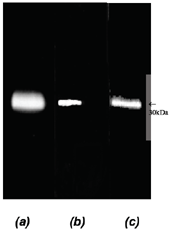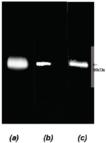Replaces Prod. #: ALX-210-298
Product Details
| Alternative Name: | PA28α, Proteasome activator complex subunit 1 |
| |
| Host: | Rabbit |
| |
| Immunogen: | Synthetic peptide corresponding to aa 5-19 of mouse PA28α. |
| |
| UniProt ID: | P97371 (mouse), Q06323 (human) |
| |
| GenBank ID: | 1698570 (mouse) |
| |
| Species reactivity: | Human, Mouse, Rat
|
| |
| Specificity: | Recognizes the α subunit of proteasome activator 11S. |
| |
| Applications: | WB
|
| |
| Formulation: | Liquid. Antiserum containing 10mM sodium azide. |
| |
| Handling: | Avoid freeze/thaw cycles. |
| |
| Shipping: | Blue Ice |
| |
| Long Term Storage: | -20°C |
| |
| Scientific Background: | The proteasome is widely recognised as the central enzyme of non-lysosomal protein degradation. It is responsible for intracellular protein turnover and it is also critically involved in many regulatory processes and, in higher eukaryotes, in antigen processing. An enzymatic cascade is responsible for the attachment of multiple ubiquitin molecules to lysine residues of proteins targeted for degradation. The 26S proteasome is the key enzyme of the ubiquitin/ATP-dependent pathway of protein degradation.
The catalytic core of this unusually large (2000kDa, 450Å in length) complex (31 subunits) is formed by the 20S proteasome, a barrel shaped structure shown by electron microscopy to comprise of four rings each containing seven subunits. 20S Proteasomes degrade only unfolded proteins in an energy-independent manner, whereas 26S proteasomes degrade native and ubiquitinylated proteins in an ATP-dependent manner. The native protein substrates are recognised by subunits, some with ATP binding sites, of the outer 19S caps of the 26S proteasome. The 19S regulatory subunit recognizes ubiquitinated proteins and plays an essential role in unfolding and translocating targets into the lumen of the 20S subunit. A second activator which can associate with the 20S proteasome in the absence of ATP is known as PA28 or the 11S regulator. The pure PA28 activator is a complex of two alternating subunits, PA28α and PA28β, which share approximately 50% homology but also show considerable similarity (30-40%) to a nuclear protein of unknown function, the Ki autoantigen (recently referred to as PA28γ). These subunits, with an apparent relative molecular weight of approximately 29kDa, form ringlike heteromeric complexes of ~200kDa possibly with an α3β3 stoichiometry. Electron microscopic studies have shown PA28 to be a ring shaped particle which, like the 19S, caps the 20S proteasome, by binding to the α-rings, at both or either end. The complex may, however, be readily dissociated. The finding that PA28 modulates the proteasome-catalysed production of antigenic peptides presented to the immune system on MHC class I molecules indicates a cellular function of this activator in antigen processing. Several genetic diseases are associated with defects in the ubiquitin-proteasome pathway. Some examples of affected proteins include those linked to cystic fibrosis, Angelman's syndrome, and Liddle syndrome. |
| |
| Regulatory Status: | RUO - Research Use Only |
| |

Luminograph of (a) mouse liver preparation, (b) human placental proteasome preparation, and (c) HeLa cell lysate after PAGE followed by blotting onto nitrocellulose and probing with antibody BML-PW8185. Antibody dilution 1:1000 using ECL procedure (1 min exposure).
Please mouse over
Product Literature References
Reduction in PA28αβ activation in HD mouse brain correlates to increased mHTT aggregation in cell models: K.W. Geijtenbeek, et al.; PLoS One
17, e0278130 (2022),
Abstract;
Fish Oil Diet during Pre‐mating, Gestation, and Lactation in Adult Offspring Rats on Cancer Cachexia Prevention: S.C.P. Oliveira, et al.; Mol. Nutr. Food Res.
65, e2000863 (2021),
Abstract;
Skeletal Muscle Denervation Investigations: Selecting an Experimental Control Wisely: H. Liu, et al.; Am. J. Physiol. Cell Physiol.
316, C456 (2019),
Abstract;
Detection of active proteasome structures in brain extracts: proteasome features of August rat brain with violations in monoamine metabolism: P.A. Erokhov, et al.; Oncotarget
8, 70695 (2017),
Abstract;
Full Text
Metformin treatment modulates the tumour-induced wasting effects in muscle protein metabolism minimising the cachexia in tumour-bearing rats: A.G. Oliveira, et al.; BMC Cancer
16, 418 (2016),
Application(s): Immunoblotting,
Abstract;
Full Text
General Literature References
PA28 subunits of the mouse proteasome: primary structures and chromosomal localization of the genes.: E. Kandil et al.; Immunogenetics
46, 337 (1997),
Abstract;
Structural and functional properties of proteasome activator PA28.: L. Kuehn & B. Dahlmann; Mol. Biol. Rep.
24, 89 (1997),
Abstract;
A role for the proteasome regulator PA28alpha in antigen presentation.: M. Groettrup et al.; Nature
381, 166 (1996),
Abstract;
Related Products












